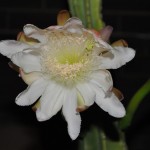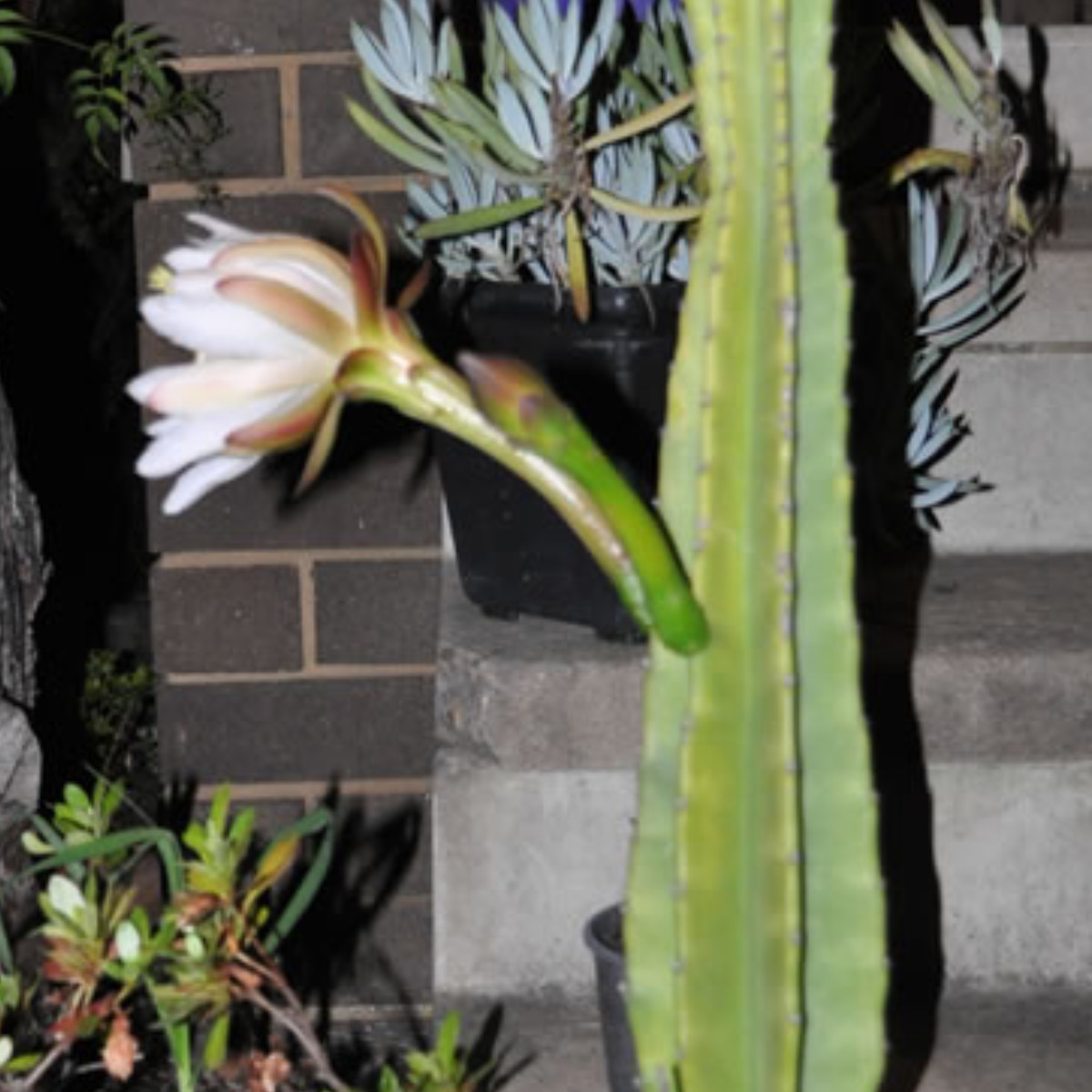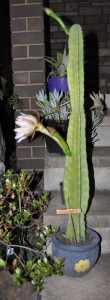Family: Cactaceae
Synonymous: Piptanthocereus jamacaru
Piptanthocereus cabralensis
Cereus calcirupicola
Piptanthocereus calcirupicola
Cereus calcirupicola
Piptanthocereus cipoensis
Cereus calcirupicola
Piptanthocereus goiasensis
Cereus goiasensis
Distribution and habitat: Cereus peruvianus is a large, erect, thorny columnar cactus up to 9m (30 feet) tall when growing in the wild. Though less gigantic in pots, they are much admired for their sculptural, columnar shape, which contrasts impressively with that of most other plants in any collection of cacti. Cereus peruvianus is native from rocky outcrops and the savanna in South America.
Description: Cereus peruvianus is a bluish green single column that branches out toward the top in the wild, but is unlikely to do o as a potted plant. I has five to eight broad, prominent notched ribs separated by deep, narrow indentations. Areoles in the notches are filled with white hairs and each areole bears a cluster of about seven brown spines, which are unlikely to grow more than 1-2cm (0.4-0.8 inch) long indoors.
Flowers which are generally produced on large specimens only, are about 15cm (6 inch) long and have white petals tinged with brownish green. Cereus peruvianus flowers in summer and opens at night time. Each flower blooms only one night and then dies.
The flowers are followed by red fruits 2.5-5cm (1-2 inch) in diameter.
Houseplant care: Cereus peruvianus is a very fast grower. This plant is a perfect candidate indoor plant for a sunny south, east or west window.
Light: Grow Cereus peruvianus cacti in the fullest possible sunlight. Since the light coming from a window is one-sided, a columnar plant will tend to lean in that direction and so it is most important to turn such plant frequently. If possible, get the Cereus peruvianus outdoors during the summer months for fresh air and extra light to improve their colour and to help lengthen their spines.
Temperatures: Normally warm temperatures are usually suitable in spring, summer and autumn. For the winter these plants should be moved into a cool position - around 10C (10F), if possible - where they can rest. A Cereus peruvianus that tries to continue growing in poor light of the short-day months will develop an abnormally thin, frail stem.
Watering: During the active growth period water moderately, but allow the top centimetre (0.4 inch) or so of the mixture to dry out before watering again. During the winter rest period giveCereus peruvianus just enough water to prevent the mixture from drying out.
Fertilising: At the beginning of the growth period apply a dressing of slow release fertiliser and stir it into the surface of the soil in the pot. Alternativelly , this fertiliser may be incorporated in potting mixture when repotting.
Potting and repotting: Either a peat based or soil based mixture will do well. For better drainage add one part coarse sand to two parts of the basic mixture. Plants up to 5cm (2 inch) wide may be kept in 8cm (3 inch) pots, but these cacti are fast growing and may need to be moved into a larger pots at least once a year. Remove every plant from its pot in early spring to see whether the roots are tightly packed. If they are, move the plant into a pot one size larger; otherwise, return it to its current pot, but top-dress it with fresh potting mixture.
Gardening: When grown outdoors, in the right conditionsCereus peruvianus will grow 0.6-1.2m (2-4 feet) a year. Often grow over 6m (20 feet) high with many branching arms. Full sun is best for fruiting, but it will also grow in the shade or even as a houseplant. Plant it in well draining soil that retains moisture. It needs more water than the other cacti and it will need regular watering during the heat of summer. Top dress with rich mulch in spring and use a slow release fertiliser to feed the plant. Cereus peruvianus is hardy down to -6C (20F) when planted in soil.
Propagation: New plants are normally raised from seeds. But, although these seeds germinate and grow up more quickly than those of most cacti, seed propagation is still a slow process. A Cereus peruvianus can also be propagated by means of sections of stem rooted in the standard potting mixture, but this process is often impractical since it involves the virtual destruction of the original plant.
Problems:
In poorly drained potting mixture or soil or when this cactus is subjected to excessive watering it is prone to root rot.
Keep an eye out for scale or mealybugs infesting Cereus peruvianus.
Treatment: If bugs are detected on the cactus, apply an insecticidal soap to the plant according to the directions on the label.
Notes: Plant has spines or sharp edges; use caution when handling.
Recommended varieties:
In any batch of Cereus peruvianus seedlings there may be at least one specimen of a naturally occurring form known as Cereus peruvianus monstrosus - a disordered form often sought after by collectors. Instead of having one centre of growth at the top of the stem, this plant has numerous growing points and becomes covered with irregular, knob-like structures. It grows much more slowly than the usual species and is harder to maintain in cultivation, for it apparently lacks the tolerance of adverse growing condition characteristic of most types of Cereus peruvianus. If it is grown in badly drained soil, for example, Cereus peruvianus monstrosus is very likely to gradually lose its roots and rot away.
Uses: Cereus peruvianus can be used as a windowsill plant, but mainly as a floor plant as it grows tall. As houseplantsCereus peruvianus will bring an exotic air to interiors where they are.
Being drought-tolerantCereus peruvianus is suitable for xeriscaping.
Observations and statistics of scientists have shown that Cereus peruvianus neutralizes harmful electromagnetic waves emitted by the television, telephone, computer, thus placing the plant in those areas of the house where the electronics are placed is beneficial.
SUMMARY:
CHARACTERISTICS:
Foliage green
Features - flowers, fragrance
Shape upright
PROPER CARE:
Watering in rest period sparingly
Watering in active growth period moderately
Light direct
Temperature in rest period min 10C max 13C (50-55F)
Temperature in active growth period min 16C max 24C (61-75F)
Humidity low
Hardiness zone: 9a-11




